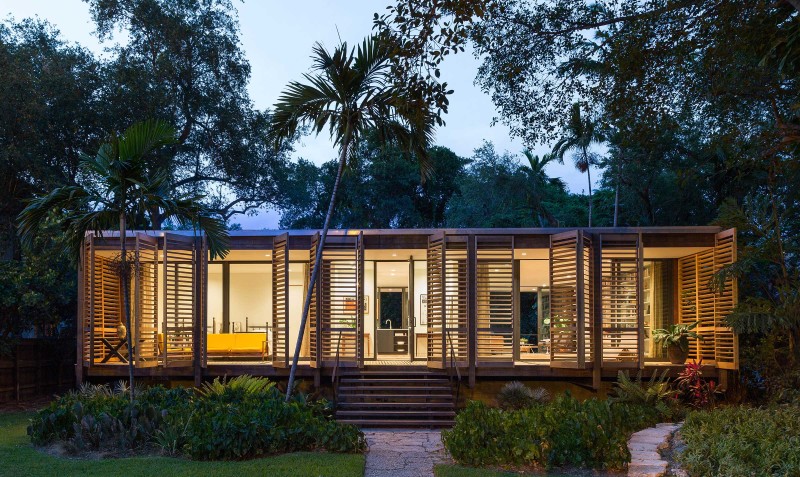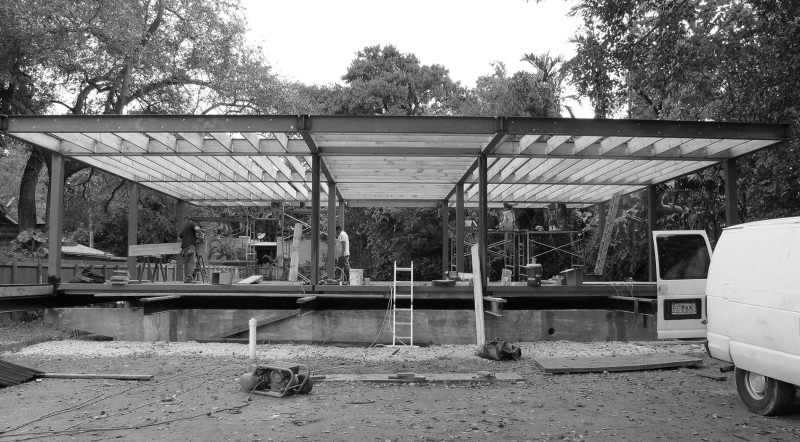 This 1,500 sq ft Brillhart House in Miami, designed and built by the Architect firm Brillhart Architecture draws upon the American glass pavilion typology, Dog Trot, and principles of Florida Modernism.
This 1,500 sq ft Brillhart House in Miami, designed and built by the Architect firm Brillhart Architecture draws upon the American glass pavilion typology, Dog Trot, and principles of Florida Modernism.
It provides a tropical refuge in Downtown Miami and also being elevated 5’ off the ground, the house benefits from 100 feet of uninterrupted glass – 50 feet spanning the length of the front and rear facades, with four sets of sliding glass doors that permit the house to be entirely opened up when desired.
 The house also includes 800 sq ft of outdoor living space, with both front and back porches. Shuttered doors along the front provide added privacy and protection against the elements. These details, and the position of the house, which is in the middle of a 330-foot long lot, allow the house to meld seamlessly with the site’s surrounding dense and lush native landscaping.
The house also includes 800 sq ft of outdoor living space, with both front and back porches. Shuttered doors along the front provide added privacy and protection against the elements. These details, and the position of the house, which is in the middle of a 330-foot long lot, allow the house to meld seamlessly with the site’s surrounding dense and lush native landscaping.
 The owners, architects and general contractors physically built most of the house themselves. Tectonics, materiality and the logic of construction became of primary interest. In a part of the country where concrete is the primary construction material, they opted for a more sustainable steel and glass superstructure, explored a combination of wood finishes, and made continued investigations into construction assemblies and innovations.
The owners, architects and general contractors physically built most of the house themselves. Tectonics, materiality and the logic of construction became of primary interest. In a part of the country where concrete is the primary construction material, they opted for a more sustainable steel and glass superstructure, explored a combination of wood finishes, and made continued investigations into construction assemblies and innovations.
Page Topics
 DESIGN CONCEPTS:
DESIGN CONCEPTS:
The design for this house relied on a back-to-basics approach – specifically studying old architectural models that care about good form but are also good for something. Each design decision was organized around four central questions that challenged the culture for building big:
- What is necessary;
- How can we minimize our impact on the earth;
- How do we respect the context of the neighborhood; and
- What can we really build?
 CONSTRUCTION AND DETAILS:
CONSTRUCTION AND DETAILS:
Steel and Glass Superstructure:
Harking back to the optimism and experimentation of South Florida’s postwar architecture, we sought an alternative to the use of concrete and concrete only. Instead the architects explored using steel and glass as the superstructure. As a result, fewer materials were wasted, the assembly was more simplified and the cost and time of construction was reduced, all the while allowing for increased cross ventilation and a heightened sense of living within the landscape.
 Glass and Insulation:
Glass and Insulation:
With modern advances in the thermal qualities of glass and insulation, the use the tropical modern concepts were able to be used alongside current Florida Building Code requirements. To meet and/or exceed the required R-Values*, they included insulation on all six sides, (icynene and rigid insulation) as well as 9/16′′ thick thermal glass.
 They also had to design new assemblies in the process. For one, the new code just came out with requirements to insulate the floor if elevated. As this was a new requirement — they had to develop an entirely new floor detail – creating a sandwich with plywood underneath on top of a layer of rigid insulation.
They also had to design new assemblies in the process. For one, the new code just came out with requirements to insulate the floor if elevated. As this was a new requirement — they had to develop an entirely new floor detail – creating a sandwich with plywood underneath on top of a layer of rigid insulation.
 Meanwhile, in order to achieve the R-Value* on the roof and accommodate a slight slope, they designed a similar but inverse concept – installing tapered rigid insulation on the roof, with a layer of plywood underneath followed by icynine below.
Meanwhile, in order to achieve the R-Value* on the roof and accommodate a slight slope, they designed a similar but inverse concept – installing tapered rigid insulation on the roof, with a layer of plywood underneath followed by icynine below.
(*The R-value is a measure of thermal resistance used in the building and construction industry. It is expressed as the thickness of the material divided by the thermal conductivity. The higher the number, the better the building insulation’s effectiveness. The design for the roof insulation resulted in a R-Value that exceeded what was required.)
 Off the Shelf Materials and Kit of Parts:
Off the Shelf Materials and Kit of Parts:
The aim was to use as many off the shelf materials as possible to keep the cost of the project down and developed a kit of parts, for example;
- The depth of the house was 50 feet, which was based on the longest length of a steel beam that does not require an oversized road permit.
- The width of the house was adjusted to fit standard commercial storefront sliding doors.
- The structural spans were kept under 20 feet, therefore dimensional lumber (i.e. 2” x 8”, 2”x10” and 2”x12”) could span the flooring and roof systems.
 Sixteen shuttered doors were built using weather resistant Western Red Cedar for along the outer edge of the front porch for added privacy and protection against the elements. The shutters make the space much cooler while also allowing for cross breezes when the sliding glass doors are open behind.
Sixteen shuttered doors were built using weather resistant Western Red Cedar for along the outer edge of the front porch for added privacy and protection against the elements. The shutters make the space much cooler while also allowing for cross breezes when the sliding glass doors are open behind.
The light that filters through these shutters during the day is stunning. At night, the shutters are aglow from behind, creating the sense of an almost magical Japanese tea house.
 The Flooring and Decking was built from White Oak and Cypress to seamlessly merge the indoors with the outdoors. The interior flooring and outdoor decking were matched as much as possible. The interior floors are 6” wide natural white oak floors. For consistency, a light decking material was needed and a select grade of cypress was opted for. Both the interior and exterior woods were given the same color stain.
The Flooring and Decking was built from White Oak and Cypress to seamlessly merge the indoors with the outdoors. The interior flooring and outdoor decking were matched as much as possible. The interior floors are 6” wide natural white oak floors. For consistency, a light decking material was needed and a select grade of cypress was opted for. Both the interior and exterior woods were given the same color stain.
 For the kitchens and bathrooms, American Cherry wood was used. For all of the door frames, interior louvered doors, (designed to be the vented AC door and vented pantry door) bathroom and kitchen cabinets, and all were lightly oiled.
For the kitchens and bathrooms, American Cherry wood was used. For all of the door frames, interior louvered doors, (designed to be the vented AC door and vented pantry door) bathroom and kitchen cabinets, and all were lightly oiled.
LIVING IN THE LANDSCAPE:
 With understanding and knowledge of the Tropical Modern models and the typology of the glass pavilion – and then integrating those ideas with new technologies — they were able to achieve a design that was not only liveable but also one that had an immediate relationship with the surrounding landscape. Because of that, the selection of flora became as important to the architectural experience as the structure itself. The integration of low-tech sustainability measures that were reliant on natural systems received great attention as well.
With understanding and knowledge of the Tropical Modern models and the typology of the glass pavilion – and then integrating those ideas with new technologies — they were able to achieve a design that was not only liveable but also one that had an immediate relationship with the surrounding landscape. Because of that, the selection of flora became as important to the architectural experience as the structure itself. The integration of low-tech sustainability measures that were reliant on natural systems received great attention as well.
To learn more about this architecture firm, or to see progress stages of the build, please click here
Related Galleries and Rooms You May Like:



